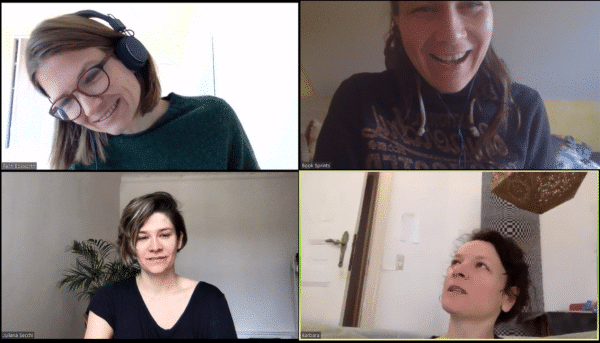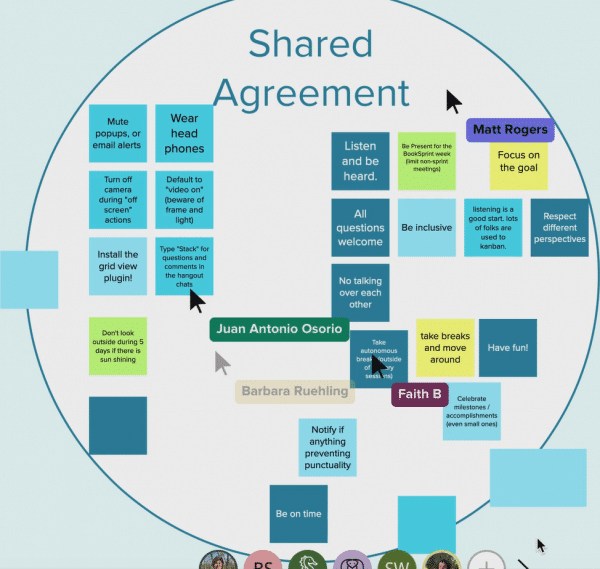What a facilitator does in a Virtual Book Sprint
A Book Sprint relies on high commitment from the participants, a dedicated working space and strong facilitation. While there is an obvious pattern across all Book Sprints, the range of client needs, participants and subjects we encounter result in very different Sprints. The facilitator often has to change course and develop new strategies along the way, especially in the new terrain of a virtual Book Sprint. We take advantage of this moment of shifting from onsite to online facilitation, to reflect on the different roles and tasks of the facilitator: From preparing for a Virtual Book Sprint, to guiding the group through the process, and ensuring that the process results in a great book.
Preparing for the Virtual Book Sprint
Designing the process
To start the preparations for a Book Sprint, the facilitator creates a strategy for the particularities of each group and book project and adjusts the Book Sprints method accordingly. She designs the virtual process with specific facilitation techniques and a selection of tools. Depending on the scope of the book and the participants’ time zones, she breaks the Book Sprint down into a mix of synchronous sprint blocks and self-paced phases with clear tasks.

Facilitator meeting to design the process
Onboarding of the participants
The facilitator consults the client on getting together the right constellation of contributors to get the desired book done. A group between 5 and 15 participants, whose various expertise and experience covers all of the subjects addressed in the book, works best. The participants go through a very iterative, interdependent and collaborative process where every part of the book goes through several edits. Thus, the full time commitment of all the people involved is crucial to the outcome of the book. To set expectations, the facilitator hosts a kick-off meeting prior to the Book Sprint, to map the process, set up the tools, agree on commitment, and to get everyone ready to go.
Setting up the space
The facilitator carefully selects the right mix of tools to create an environment that supports the collaborative writing process. In addition to a video-conferencing tool for plenary discussions and breakouts, the facilitator employs a range of other collaborative tools. Each tool fulfills specific tasks, and switching between tools helps mitigate the fatigue of long conference calls.
Visual collaborative tools like Mural or Miro offer great support for brainstorming, consensus-mapping and decision-making. They help the facilitator and the group to keep a record of what has been discussed in large or small groups and are crucial for ensuring that tasks are adequately monitored. The group writes in Editoria, which is an html-based collaborative book production platform that generates automated typesetting and exports immediate epub and pdf files. For drafting, commenting and editing illustrations the facilitator and illustrators use the collaborative design application Figma. To coordinate parallel conversation streams the facilitator sets up several chat channels using tools like Slack or Mattermost. Those chat tools also provide the space for casual conversations and off-topic exchange among participants.
Collaboratively creating illustrations in Figma
Despite ever adjusting the virtual collaborative space, it is the facilitator’s task to leverage participant’s different skill levels. Some participants might be overwhelmed by new technologies and feel insecure about using them, and one-on-one walk-throughs with the facilitator can get them comfortable with the tools.
Guiding the process
Facilitating conversations
The Book Sprints facilitator holds the virtual space for the group of writers to come together, share their ideas and create a shared mental model of an often complex topic. She guides the conversation on the scope, audience, and style of the book and steers the writers through the multiple decisions which have to be made in a collective book-creation process.
Together with the group the facilitator establishes a shared agreement on how to engage in online discussions at the start of the Virtual Book Sprint. For example, using visual signs for soft approvals or disagreement and queuing comments or questions in the chat window.

Working on a shared agreement in Mural
Long discussions online can be draining. To keep them on point, the facilitator visualises as much of the key decisions and open questions as possible and leads the group to consensus. When conversations lose momentum, when participants circle back on decisions already taken, the facilitator moves the group towards the next step. She pushes participants to start writing down their ideas at an early stage, even though they might not yet be fully developed. In Book Sprints, a lot of the discussions happen through the writing. Discussions get more focussed and tangible, when they are based on concrete written material. As soon as an idea is out of someone’s head, it can be passed on to others for revisions and shared decision-making. The facilitator also cultivates trust amongst the group members and gives them the confidence that writing the book in a few days is something they can accomplish.
Managing the workflow
The result of a Book Sprint is a text written by a group of authors together who share ownership and create a collective voice. This is accomplished by an iterative process of structuring, drafting and several rounds of editing. The facilitator moves the participants to work on different parts of the book according to their expertise and their abilities. Although the facilitator is a member of the group, she never takes part in actual writing, nor does she weigh in with opinions about the content.

Drafting content in Editoria
So that participants can focus on the task in front of them, the facilitator maintains the overview, delegates tasks and keeps track of time. She removes obstacles, makes sure that everything gets done in time and nothing falls off the table. The organic style of Book Sprint facilitation requires a more structured and explicit approach in the virtual context. Communication is more directed and the workflow itself more transparent. Explaining each step of the process, and scheduling progress reports at different points during the day are now crucial elements.
Balancing group dynamics
The facilitator constantly reads the group, pre-empting obstacles to collaboration and productivity, and adapting the strategy accordingly.
Intensified by the pressure of the tight deadline, participants typically experience a range of emotions and reactions; feeling overly excited, feeling blocked, disrupting the group and the project, or prioritizing personal agendas over collective goals. We use a light-touch approach and accommodate different personalities and work styles, to ensure that the contributions are constructive and the group remains productive. Sometimes this means carefully mediating potential and real conflict.
It is more challenging to monitor group dynamics and maintain momentum virtually. In person, reading body cues, overhearing subtle remarks and having casual conversations with participants gives the facilitator a lot to work with. To make sense of the group in a Virtual Book Sprint, the facilitator needs to adapt her strategies. In addition to deep listening in plenary discussions, the facilitator moves through the breakout groups, follows chat conversations and checks in with participants individually. The facilitator might also select some participants to head a breakout discussion and act as interlocutors to keep track of progress.
Coordinating the book production
While the facilitator guides the participants through the writing process, she also coordinates the Book Sprints production team. The team works remotely and around the clock to copy-edit the language, turn sketches into illustrations and create a customized book design. Connected across at least 7 different countries and timezones from South Africa to New Zealand, the remote team is specialized on the Sprint process and turns around tasks quickly.
When the group of writers goes to bed, the team of editors revises the text produced by the writers during the day. They report back on structural issues, clarity, tone, and voice, and suggest improvements. On the basis of the editors’ report the facilitator plans the daily activities ahead. Similar to the writing, the creation of the visual style, illustrations and a book design is an iterative process that is moderated by the facilitator. She ensures that participants’ ideas are translated well to the remote team, so that by the end of the Sprint there is a designed, illustrated and copy-edited book approved by the writers.
Creating the book layout in Editoria
Updating the facilitation tool box
Every single Book Sprint is a unique experience – also for the facilitator. To debrief and share learnings, our team of facilitators runs regular meetings and constantly expands our skillset. Our facilitators don’t follow a schematic formula but make use of a growing set of different writing, editing and facilitation tools.
Our recently founded Sprint Lab (https://www.booksprints.net/sprintlab/) is a critical step to stay on the cutting edge of facilitation methodology. In the Lab, our facilitators bring their experience of over ten years of Book Sprint facilitation, and of their other life experiences in mindfulness coaching, conflict transformation, and teaching, to design new methods for sprinting. The fully virtual format is the latest of these.
